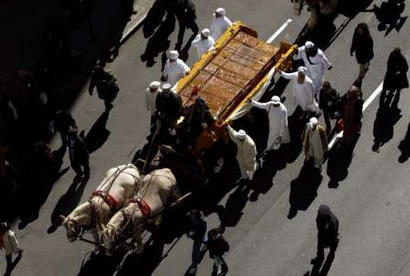
A group of caskets moves up Broadway today, holding remains beyond just bones
Yes, New York had slaves, and apparently they weren't all barbers and musicians.
Some of them, all still anonymous, are being returned tomorrow to the downtown Manhattan site of their burial in the seventeenth and eighteenth centuries
Twelve years after workers accidentally uncovered a burial ground for colonial era blacks in downtown Manhattan, the remains arrived Friday, headed for the empty lot where they were first discovered.Without a lot of in-the-face activism on the part of some dedicated New Yorkers over the last 12 years, we would hardly be aware of this part of our history even today.The remains, scheduled to be reinterred Saturday, arrived at Pier 11 at Wall Street on three police boats, in four small wooden coffins carved in Ghana. New York was the last stop on a five-city procession.
After a ceremony at South Street Seaport, the coffins were scheduled to be taken by procession to the African Burial Ground, located at the intersection of Duane and Elk streets.
Initially, the federal government tried not to comply with legal mandates about what to do in such a situation. But African American New Yorkers, including then Mayor David Dinkins, pressed the government to respect the remains found there and to find a way to honor this sacred space. After vigils and protests and religious observances and meetings held at the site by many in the community, construction was halted until all the remains could be unearthed and moved to be studied, with the promise that they would be re-interred back at the site.Brian Lehrer devoted part of his WNYC program this morning to the early history of Africans in New York and the events of today and tomorrow. What scientists found in 10 years study of the bones now being brought back to New York was evidence of disease and the stress of carrying heavy loads. It was established that most were born in Africa, specifically west and central Africa, and that both the death rate and the rate of reproduction were extrordinarily poor. The data suggests that the slaves were treated as expendable, and that attrition was addressed by bringing in more.
The NYTimes devoted half of a page to the story in yesterday's editions.
Not one of the skeletons in the burial ground could be linked to a person with a name, [urban anthropologist Dr. Sherrill D.] Wilson said. She says this is evidence that "these people were undocumented because they were viewed as a disposable population." Also, she said, almost half of the bodies found were children, which suggests "they were literally worked to death."Slavery ended in New York in 1827, but the story continues.
For more information, including that about events this week, see the African Burial Ground site.
A FOOTNOTE:
It was during the Brian Leher Show, in a section not included in the on-line report linked above, that I heard about several caucasian bodies found buried with the others.
How could that be, in a 6-acre cemetary which the city had made necessary because blacks were not allowed to bury their own in the same ground with whites?
In 1741 New York thought it was the victim of a slave conspiracy or uprising, because of a series of unexplained fires. When the hysteria had subsided, 31 slaves and 5 free whites, suspected sympathizers or accomplices, had been executed. The authorities decided to visit the worst possible humiliation upon the caucasians; they were interred along with the slaves.
Africans customarily buried their dead facing west. The bodies of the sympathizers appeared to be lovingly laid facing east, the custom of their time and people.
[image from REUTERS/Chip East]